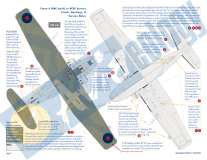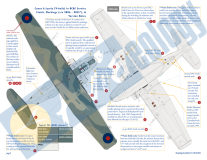- Aviaeology Shop
- >
- Decal Sets
- >
- Decals 'n Docs
- >
- 1/48 scale Decals 'n Docs
- >
- RCAF Canso A (PBY-5A) collection 1: The sub-killers of 162 (BR) Squadron
RCAF Canso A (PBY-5A) collection 1: The sub-killers of 162 (BR) Squadron
SKU:
AOD48024
CA$16.99
CA$16.99
Unavailable
per item
• Includes the F/L David Hornell Victoria Cross action aircraft
• Decals to model up to 3 (if subjects featuring each variant of national markings are chosen) of the 6 photo-documented subjects or 4 bonus (based on carefully interpreted graphic reconstructions) significant-action aircraft.
• Twelve 8.5 x 11 in. pages of illustrated documentation*
Aircraft covered in this set:
Photo-documented subjects
• Canso A 9750 / DZ•A, Yarmouth, Nova Scotia 1942-43
Representative of a Consolidated-built Canso A in the Squadron’s initial Eastern Air Command finish and markings scheme.
• Canso A 9754 / P, 'MARY K', Wick, Scotland
U-1225 sunk but aircraft lost with some fatalities, 24 June 1944 – F/L Hornell’s Victoria Cross (VC) action aircraft – one of the earliest Boeing Canada-built Canso As on squadron. In addition to the VC, other awards earned as a result of this action included a DSO, two DFCs, two DFMs, and two MiDs.
• Canso A 9759 / W, Reykjavík, Iceland
F/O Marshall & crew, U-300 damaged during extended Ubat, 4 August 1944.
• Canso A 9808 / O, Ballykelly (Maydown), Wick, & Reykjavík
F/L David Hornell & others flew this early Canadian Vickers-production example extensively throughout 1944. It may in fact be considered to be their regular aircraft. While based in Iceland, on the Coastal Command anti-submarine warfare course in Northern Ireland, and on temporary deployments (TDs) to Scotland, Hornell's crew flew this aircraft more than any other Canso A on strength at the time.
• Canso A 9840 / J, 'HAIRLESS JOE', Reykjavík
A representative mature-production (1st contract) Canadian Vickers-built Canso A that came to the squadron as an attrition-replacement aircraft (received after the June 1944 Ubat actions and losses).
• Canso A 11090 / X, Reykjavík
Late 1944 / early 1945 – representative of the late (2nd contract) Canadian Vickers built, ASV.II Polyplexer-equipped Canso As with other late-service mods and equipment changes. This aircraft was received during the last phase of the Squadron’s ops from Iceland.
Subjects as graphic reconstructions based on non-photographic source materials:
• Canso A 9767 / S, Reykjavík
F/O Cooke & crew, U-342 sunk, 17 April 1944. This action resulted in multiple DFC & MiD awards.
• Canso A 9816 / T, Wick
F/L MacBride & crew, U-477 sunk, 3 June 1944.
This aircraft was also used by W/C Chapman (Officer Commanding, 162 Sqn) & crew in the sinking of U-715, 13 June 1944. It was shot down during this battle with 3 fatalities. The Wing Commander was one of the survivors. This action resulted in awards of a DSO, multiple DFCs, and a DFM.
• Canso A 9841 / A, Wick & Reykjavík
Aircraft used for the squadron’s first Ubat recorded while based outside of Canada, F/L Cunningham (unidentified U-boat escaped, later determined to be U-550 which lost two crewmen KIA during the attack) on 22 February 1944 in a multiple DFC action.
This aircraft was also later used by F/L MacBride & crew during an action which resulted in U-478 being sunk (a shared victory) on a 30 June 1944 triple DFC action.
• Canso A 9842 / B, Wick
F/O Sherman & crew, U-980 sunk, 11 June 1944.
Also flown by the Sherman crew during an engagement with U-480 on 13 June 1944. Tragically, the aircraft was shot down with the loss of all but one of the crew.
*Black and white laser prints are supplied in the package, and a high resolution, home/office-printable, colour PDF version is made available via email after purchase (automatically sent for direct-purchase customers). Documentation includes decal placement and comprehensive painting instructions for all subject aircraft variations, in addition to illustrated articles (notes pages with photos and/or scale illustrations) on:
- Canso wing centre-section hardpoint details;
- RCAF-specific offensive ordnance loadouts for Canso aircraft (including A/S bombs, depth charges, and homing torpedo options);
- Defensive armament variations, including Consolidated (factory) as well as the early and late RCAF Service flak-suppression mods;
- ASV.II radar aerials according to subject – dual-mode LRASV and Polyplexer variations;
- RCAF-specific r/t & w/t aerial configurations;
- All four wartime RCAF finish and markings scheme and detail equipment variations used during the period of service covered.
A separate general decal preparation / application instruction sheet completes the package.
Photo-documented subjects
• Canso A 9750 / DZ•A, Yarmouth, Nova Scotia 1942-43
Representative of a Consolidated-built Canso A in the Squadron’s initial Eastern Air Command finish and markings scheme.
• Canso A 9754 / P, 'MARY K', Wick, Scotland
U-1225 sunk but aircraft lost with some fatalities, 24 June 1944 – F/L Hornell’s Victoria Cross (VC) action aircraft – one of the earliest Boeing Canada-built Canso As on squadron. In addition to the VC, other awards earned as a result of this action included a DSO, two DFCs, two DFMs, and two MiDs.
• Canso A 9759 / W, Reykjavík, Iceland
F/O Marshall & crew, U-300 damaged during extended Ubat, 4 August 1944.
• Canso A 9808 / O, Ballykelly (Maydown), Wick, & Reykjavík
F/L David Hornell & others flew this early Canadian Vickers-production example extensively throughout 1944. It may in fact be considered to be their regular aircraft. While based in Iceland, on the Coastal Command anti-submarine warfare course in Northern Ireland, and on temporary deployments (TDs) to Scotland, Hornell's crew flew this aircraft more than any other Canso A on strength at the time.
• Canso A 9840 / J, 'HAIRLESS JOE', Reykjavík
A representative mature-production (1st contract) Canadian Vickers-built Canso A that came to the squadron as an attrition-replacement aircraft (received after the June 1944 Ubat actions and losses).
• Canso A 11090 / X, Reykjavík
Late 1944 / early 1945 – representative of the late (2nd contract) Canadian Vickers built, ASV.II Polyplexer-equipped Canso As with other late-service mods and equipment changes. This aircraft was received during the last phase of the Squadron’s ops from Iceland.
Subjects as graphic reconstructions based on non-photographic source materials:
• Canso A 9767 / S, Reykjavík
F/O Cooke & crew, U-342 sunk, 17 April 1944. This action resulted in multiple DFC & MiD awards.
• Canso A 9816 / T, Wick
F/L MacBride & crew, U-477 sunk, 3 June 1944.
This aircraft was also used by W/C Chapman (Officer Commanding, 162 Sqn) & crew in the sinking of U-715, 13 June 1944. It was shot down during this battle with 3 fatalities. The Wing Commander was one of the survivors. This action resulted in awards of a DSO, multiple DFCs, and a DFM.
• Canso A 9841 / A, Wick & Reykjavík
Aircraft used for the squadron’s first Ubat recorded while based outside of Canada, F/L Cunningham (unidentified U-boat escaped, later determined to be U-550 which lost two crewmen KIA during the attack) on 22 February 1944 in a multiple DFC action.
This aircraft was also later used by F/L MacBride & crew during an action which resulted in U-478 being sunk (a shared victory) on a 30 June 1944 triple DFC action.
• Canso A 9842 / B, Wick
F/O Sherman & crew, U-980 sunk, 11 June 1944.
Also flown by the Sherman crew during an engagement with U-480 on 13 June 1944. Tragically, the aircraft was shot down with the loss of all but one of the crew.
*Black and white laser prints are supplied in the package, and a high resolution, home/office-printable, colour PDF version is made available via email after purchase (automatically sent for direct-purchase customers). Documentation includes decal placement and comprehensive painting instructions for all subject aircraft variations, in addition to illustrated articles (notes pages with photos and/or scale illustrations) on:
- Canso wing centre-section hardpoint details;
- RCAF-specific offensive ordnance loadouts for Canso aircraft (including A/S bombs, depth charges, and homing torpedo options);
- Defensive armament variations, including Consolidated (factory) as well as the early and late RCAF Service flak-suppression mods;
- ASV.II radar aerials according to subject – dual-mode LRASV and Polyplexer variations;
- RCAF-specific r/t & w/t aerial configurations;
- All four wartime RCAF finish and markings scheme and detail equipment variations used during the period of service covered.
A separate general decal preparation / application instruction sheet completes the package.















